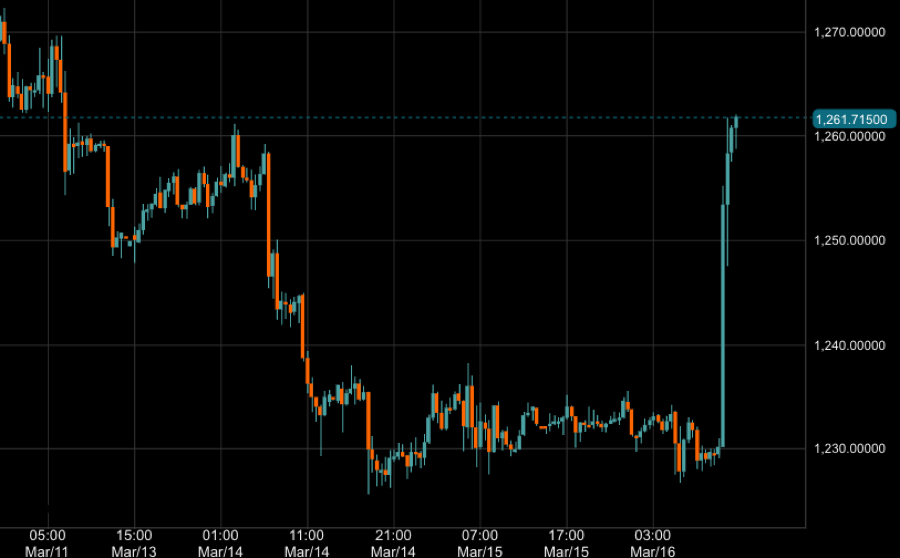The Fed’s just kicked the gold price back into bull market

Source: Sharps Pixley
Following some profit-taking on Monday and Tuesday, gold’s 2016 rally regained momentum on Wednesday with the metal exchanging hands for an intra-day high $1,261.70 an ounce in late afternoon trade, up $30.70 or 2.5% from yesterday’s close.
Gains in Comex futures for delivery in April was inspired by a US Federal Reserve interest rate decision to keep rates on hold. Gold touched a near six-year low of $1,049.60 December 17 but 2016’s bull run has seen the precious metal gain just over 20% since then. A bull market is a 20% upward move from a low.
Any indications that the Fed is showing less enthusiasm for rate hikes is bullish for gold, as we saw today
While the announcement was expected the statement by the central bank indicated only one more rate hike this year compared to four previously. The central bank raised rates from zero in December, the first such move in nine years. The Fed statement wasn’t only cautious about the health of the US economy but also warned “global economic and financial developments continue to pose risks”.
Interest rates near zero is beneficial to gold because the metal is not yield-producing and the Fed on Wednesday said it’s keeping its target of a federal funds rate between 0.25% and 0.5%. Lower rates also hurt the dollar and the Fed comments sent the US dollar index down nearly 1% to the lowest since mid-February. The dollar and gold, and bond yields and gold have strong negative correlations.
“Any indications that the Fed is showing less enthusiasm for rate hikes is bullish for gold, as we saw today,” Brien Lundin, editor of Gold Newsletter told MarketWatch. “Any indication that they’ll have to forestall hikes altogether, or even revert to easing, would send gold catapulting higher.”
Marc Faber, economist, investment guru and Wall Street stalwart, last year said the Fed will likely have to backtrack on its decision to lift-off from near zero rates (and its ending of its quantitative easing policy a year ago).
Faber said far from a rising interest rates environment and tighter credit, 2016 will see a resumption of asset purchases by the Fed under a fourth round of QE to pump easy money into financial markets.
We’re not quite there yet, but today’s cautious tone from monetary officials make Faber’s prediction less of an outlier.
The imposition of negative rates is a sign of distress, which is gold-bullish
While the upward trend for US interest rates may be stalling, a few developed economies have moved into uncharted monetary policy territory with negative interest rate.
BusinessInsider Australia quotes James Steel, chief precious-metals analyst at investment HSBC on the matter referring to a report by the Bank of International Settlements (the central bank of central banks):
How does this play out for gold? Positively we think. The imposition of negative rates is a sign of distress, which is gold-bullish. Furthermore, the uncertainty surrounding the long run impact of negative rates as outlined in the BIS report is also supportive of gold. The BIS report seems to say that negative rates have brought uncertainty, especially as regards their impact on financial intermediaries, but have not delivered hoped for gains for households and businesses. This is to gold’s benefit.
More News
Barrick fined for releasing excessive cobalt into British Columbia river
The fine relates to 17 separate incidents between 2021 and 2023 at the now-closed Nickel Plate gold mine.
March 15, 2025 | 01:58 pm
Buenaventura selects Sandvik to provide 36-unit fleet in Peru
Sandvik will deliver a 36-unit fleet of underground equipment to three mine operations.
March 14, 2025 | 02:59 pm
{{ commodity.name }}
{{ post.title }}
{{ post.excerpt }}
{{ post.date }}



Comments
Marshall Clark
They just kicked it back down today